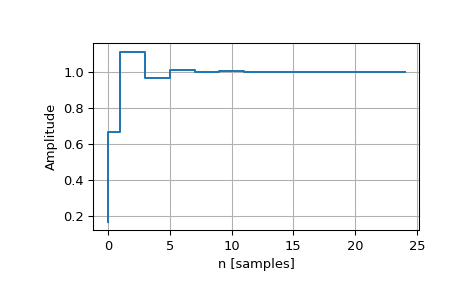dstep — SciPy v1.16.0 Manual (original) (raw)
scipy.signal.
scipy.signal.dstep(system, x0=None, t=None, n=None)[source]#
Step response of discrete-time system.
Parameters:
systemdlti | tuple
An instance of the LTI class dlti or a tuple describing the system. The number of elements in the tuple determine the interpretation. I.e.:
system: Instance of LTI class dlti. Note that derived instances, such as instances of TransferFunction, ZerosPolesGain, or StateSpace, are allowed as well.(num, den, dt): Rational polynomial as described in TransferFunction. The coefficients of the polynomials should be specified in descending exponent order, e.g., z² + 3z + 5 would be represented as[1, 3, 5].(zeros, poles, gain, dt): Zeros, poles, gain form as described in ZerosPolesGain.(A, B, C, D, dt): State-space form as described in StateSpace.
x0array_like, optional
Initial state-vector. Defaults to zero.
tarray_like, optional
Time points. Computed if not given.
nint, optional
The number of time points to compute (if t is not given).
Returns:
toutndarray
Output time points, as a 1-D array.
youttuple of ndarray
Step response of system. Each element of the tuple represents the output of the system based on a step response to each input.
Examples
The following example illustrates how to create a digital Butterworth filer and plot its step response:
import numpy as np from scipy import signal import matplotlib.pyplot as plt ... dt = 1 # sampling interval is one => time unit is sample number bb, aa = signal.butter(3, 0.25, fs=1/dt) t, y = signal.dstep((bb, aa, dt), n=25) ... fig0, ax0 = plt.subplots() ax0.step(t, np.squeeze(y), '.-', where='post') ax0.set_title(r"Step Response of a 3rd3^\text{rd}3rd Order Butterworth Filter") ax0.set(xlabel='Sample number', ylabel='Amplitude', ylim=(0, 1.1*np.max(y))) ax0.grid() plt.show()
